Might as well be chasin’ the wind (of change) on this Music Monday.
The last few weeks, I’ve been covering the power ballad/soft rock era of Chicago, which was the second era of the group’s lengthy legacy. Though the era began in 1982 with Chicago 16, it was 1984’s Chicago 17 that solidified Chicago’s place in the era of the power ballad. Winds of change happened after their most successful album, with one original member leaving for the lofty ambitions of a solo career. A new tenor voice ushered in 1986’s Chicago 18. By 1988, the group released Chicago 19, and officially wrapped up Chicago’s first twenty years in the music industry, as well as the 1980s.
Between 1989 and 1990, the group released a Greatest Hits album to commemorate their life in the 1980s (Greatest Hits 1982-1989), performed a song for the Days of Thunder soundtrack (“Hearts in Trouble”), and changed personnel once again. Out was original member and drummer Danny Seraphine, fired after the conclusion of the band’s 1989 tour to promote Chicago 19. In was Tris Imboden, who had previously toured with Kenny Loggins since 1977. Oh, and they spent 1990 doing something else.
They called it Twenty 1

Chicago Twenty 1 is the seventeenth studio album by Chicago, released in January 1991. The group spent 1990 recording what was to be their first album of the 1990s, and another addition to this new sound the group had been working with for the last decade. Relying on the outside influence of writers they’d been working with the last few years, Chicago also retained Ron Nevison from their previous album as a producer. The result for this album was, well, about a step above Chicago XIII and Chicago XIV.
I mean, the sound is so much better (and not disco), but music taste and sound was changing, and this album still retains some of that power ballad feel. By the early 1990s, that wasn’t really a thing anymore. As a result, Chicago was mired in an ocean of music that adapted to the times, something they once again found themselves on the wrong side of. But again, it wasn’t a disco sound they found themselves in. They weren’t that out of touch.
Singles and Music Videos

Three singles were released for Twenty 1 – “Chasin’ The Wind” in January 1991, “Explain it to My Heart” in April 1991, and “You Come to my Senses” in August 1991. All but one single were the work of Jason Scheff and Bill Champlin on vocals. Two tracks featured Robert Lamm. I personally feel for the guy – the 80s were not easy for him, and the songs he does contribute to this album – “One From The Heart” and “Only Time Can Heal The Wounded” – has that Robert Lamm vibe. He wrote them, after all.
“Chasin’ The Wind” and “You Come To My Senses” (which are both beautiful), charted on the Billboard charts. “Chasin’ The Wind” reached #39 on the Hot 100, and #13 on the Adult Contemporary Chart, while “You Come to My Senses” reached #11 on the Adult Contemporary chart. As for the album, during a stay of eleven weeks on the Billboard Hot 200, the album reached #66. It would be their last full-length album of original singles until 2006’s Chicago XXX.
Like in previous albums with music videos, this album has one, but only for “Chasin’ The Wind.” And well, it’s kinda artsy and very…not Chicago.
Wind, wind, and more wind, woman holding branches, band in long dark coats and sunglasses, carrying instruments, if this were anyone else, it would all make sense…I think. But it definitely didn’t feel like Chicago. However, the song is gorgeous, even if the video is just…not them.
They don’t even play these instruments in this song.
My Take
Call me biased, but this isn’t the worst album Chicago could have put out. I’ve listened to Chicago XIII, so I know what questionable sounds like. Twenty 1 doesn’t feel like that disco nightmare, but it also feels like the need for change is coming. At this point, Chicago’s “winds of change” were finding their way back to the band. With the new decade beginning, Chicago was going to have to find their way – and the sound – once again. It was a similar crossroads they faced in the late 1970s and early 1980s.
I do like the music on this album, there is a glimmer of what made Chicago great. Commercial success was starting to fade, but the next era would be more about returning to roots and recapturing the good old “rock with horns” sound that Chicago gave up in the 1980s to conform to popular (and changing) taste. All of that said, the album is worth a listen.
Chicago Twenty 1
The 1990s, and Beyond!
As the 1990s moved forward, Chicago would face yet another crossroads in their music. Years of outside influence and writers wore the group down, and they were ready to return to their greatness, to the rock that people loved.
After another “Best Of” album in late 1991 (Group Portrait, which covered the first fourteen albums) and a star on the Hollywood Walk of Fame in 1992, Chicago was ready to go back to their roots…at a cost to their record contract.
That wasn’t the only road block they’d face at the same time, but it certainly didn’t stop them.
I’m going to pick up on that in two weeks, since I already had a song choice picked for next week long in advance.
Have a great Monday, and enjoy the music!


